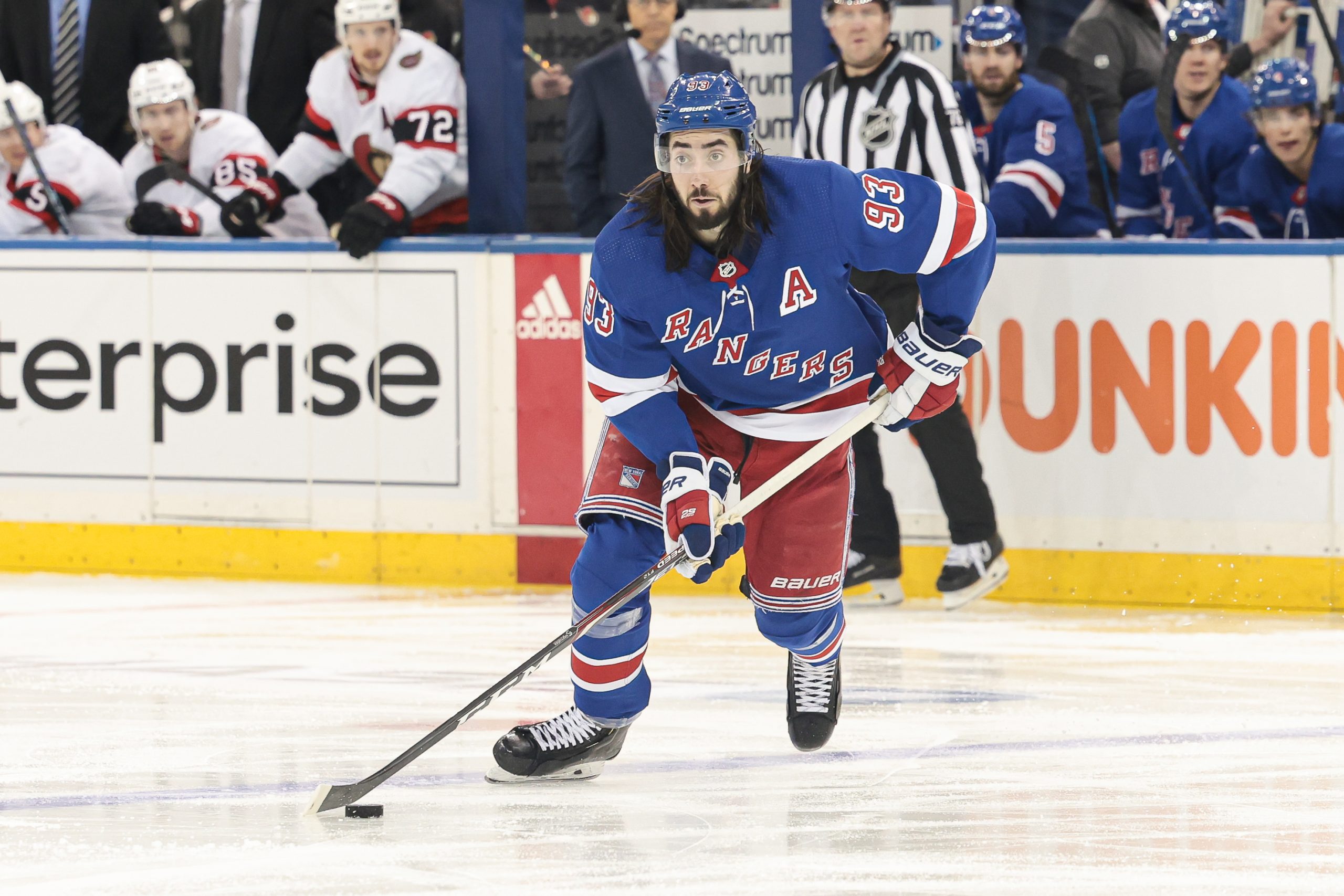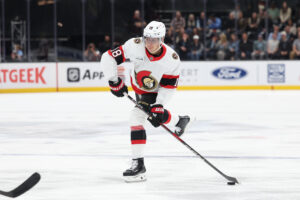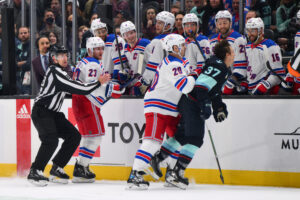NHL player development seems to always result in more questions than answers. How likely is it for a top pick to pan out? What makes a player a “steal”? Last Word On Hockey will be starting a new series on how to properly develop prospects from all different spots throughout the draft. With forwards drafted out of North American hockey leagues between 2005 and 2015, in the first round, covered, let’s shift to forwards drafted out of Europe.
NHL Player Development Of Top-Ten Picks
In the span of 2005 through 2015, there were 10 players selected within the top-ten out of Europe. Within that grouping, there were four players who made their NHL impacts (15+ games in a single season) in their DY+2 season, or, in other words, after one year of development following their selection in the draft. Those players were Nicklas Backstrom, William Nylander, Mika Zibanejad, and Magnus Paajarvi. Today, let’s look at Zibanejad and Paajarvi.
In these pieces, Last Word will be using Even-Strength Offence Goals Above Replacement (EVO), Even-Strength Defence Goals Above Replacement (EVD), Wins Above Replacement (WAR) and Goals Above Replacement (GAR). All those analytics come from Evolving-Hockey (paid subscription required).
Player Development Of Mika Zibanejad
Zibanejad, drafted sixth overall in the 2011 NHL draft by the Ottawa Senators, came out of the Djurgardens organization in Sweden. In his DY-1 season, Zibanejad played evenly across three leagues (14 games each), but Last Word looked at his J20 SuperElit stats for the season. There, he scored two goals and two assists for four points in the aforementioned 14 games, for 0.286 points per game. That ranked sixth out of the aforementioned 10 forwards in DY-1 production. The following season, Zibanejad would play 27 games in the J20 and 26 games in the top men’s league, the Elitserien, and Last Word looked at his Elitserien stats for this season. In those 26 games, he scored five goals and four assists for nine points, for 0.346 points per game. That ranked seventh amongst those same 10 forwards in DY production.
After being drafted, Zibanejad would play just nine NHL games (one assist), but would stay mainly in Sweden yet again. This time, he scored five goals and eight assists for 13 points in 26 Elitserien games, for 0.5 points per game. That ranked last out of the eight forwards still outside the NHL in DY+1 production. Despite what could be considered lackluster stats, comparably to the other forwards, he would make his first true NHL impact the next season. Let Zibanejad’s NHL player development begin.
How Zibanejad Was Used
In his rookie year, Zibanejad would play mostly up at the NHL level. However, he got into 23 AHL games, scoring four goals and seven assists for 11 points, which is a respectable statline for a rookie. Meanwhile, he played in 42 NHL games, where he averaged 13:34 time on ice per game. In what is essentially a third line role, he scored seven goals and 13 assists for 20 points, again a respectable statline. However, it was his analytics that were truly impressive. In a limited role, he managed to produce a solid EVO (4.7) and a fantastic EVD (2.0) for a rookie. Those strong even-strength numbers led to a very impressive WAR (1.7) and GAR (9.4).
After what was a very impressive rookie season, based on underlying numbers, Zibanejad would become a near-full-time NHLer. He would have a six game AHL stint, where he produced two goals and five assists for seven points. Meanwhile, Zibanejad would get to play in 69 NHL games, where he averaged 14:20 per game, a step-up from the year prior. In that role, he managed 16 goals and 17 assists for 33 points. While his production doesn’t jump off the page, it was still solid. Unfortunately, however, his underlying stats dropped. His EVO (2.1) and EVD (-0.4) were far less impressive. As expected, that led to his WAR (0.6) and GAR (2.9) to also drop by a decent margin.
Zibanejad Becomes Full-Time NHL Player In Year Three
In his third professional season, Zibanejad would kiss goodbye to the AHL. Playing in 80 NHL games, he averaged 16:26 per game, a massive upgrade to the year before. Now playing, essentially, top-six minutes with Ottawa, he would produce 20 goals and 26 assists for 46 points. Again, his raw stats don’t jump off the page. But his underlying numbers, for the most part, rebounded. His EVO (3.5) jumped up a bit, for one. But his EVD (-1.5) dropped even further. Despite that, his WAR (1.2) and GAR (6.1) were much closer to his rookie stats than his sophomore season.
Following that third NHL season, Zibanejad would play just one more season with the Senators. In that season, he scored 51 points across 81 games, his best season in Ottawa. However, he would be dealt in the infamous Derick Brassard deal to the New York Rangers, where he remains today. Since joining New York, Zibanejad has scored 197 goals and 234 assists for 431 points in 467 games, and counting. Across those seven seasons with the Rangers, he has reached a point-per-game twice, and is on pace for a third time this season. He has averaged 0.92 points per game as a Ranger versus 0.54 as a Senator (75 point pace versus 44 point pace across 82 games, respectively). Safe to say the Rangers are thrilled with Zibanejad’s NHL player development. Meanwhile, the Senators must be thinking about what could have been.
Player Development Of Magnus Paajarvi
Paajarvi, drafted 10th overall by the Edmonton Oilers in the 2009 NHL draft, came out of the Timra IK organization in Sweden. In his DY-1 season, he played primarily in the top men’s league, the Elitserien. There, he scored one goal and two assists for three points in 35 games, for 0.086 points per game. That ranked last out of the 10 forwards in DY-1 production. The next season, again in the Elitserien, Paajarvi scored seven goals and 10 assists for 17 points in 50 games, for 0.34 points per game. That ranked eighth out of those same 10 players in DY production.
After being drafted, Paajarvi would remain in Sweden for one more season. Again playing in the Elitserien with Timra, Paajarvi would have his best season. He scored 12 goals and 17 assists for 29 points in 49 games, for 0.592 points per game. That ranked seventh out of the eight forwards still outside the NHL in DY+1 production. Paajarvi’s NHL player development path was about to begin following this performance.
How Paajarvi Was Used
Making the move to North America, Paajarvi would immediately play a role for the Oilers. Slotting into 80 games, he averaged 15:23 per game, a pretty large role for a rookie. With that, he scored 15 goals and 19 assists for 34 points, a decent statline. Meanwhile, his underlying stats were mostly just okay. His EVO (2.5) was good, but not great, while his EVD (-2.3) was poor, but expected for a rookie. Meanwhile, his WAR (0.6) and GAR (3.3) were decent.
His second season would not go as smoothly. Playing between the AHL and NHL for much of the year, Paajarvi would spend 34 games with the Oklahoma City Barons. With the Barons, he scored seven goals and 18 assists for 25 points. Meanwhile, at the NHL level, he played 41 games, and averaged 13:11 per game. That’s four minutes per game less than his rookie season, a massive drop off. With that, he scored just two goals and eight total points. His underlying stats were mostly really bad. Only his EVD (1.2) was above replacement level, surprisingly enough. But his EVO (-3.9) was very bad, and it led to his WAR (-0.4) and GAR (-2.1) to fall below replacement level.
NHL And AHL Split Continues
In year three, Paajarvi would yet again split between the Barons and Oilers, almost the exact same way. This time, he would play in 38 AHL games instead of 34, where he scored four goals and 16 assists for 20 points, five less points than the year before. Then, at the NHL level, he played 42 games, which was one more than the last season. His ice time rose to 14:08 per game, nearly a minute more ice time per game. With the larger role, Paajarvi scored nine goals and 16 points. That’s more goals than total points in year two, despite playing similar roles. His underlying stats also improved. He had an EVO of 3.2, a new high. He also had an EVD of 1.0, which was similar to his score in year two. Finally, his WAR (0.6) and GAR (3.1) returned to the results of his rookie season, a step in the right direction.
Since that third season, in 2012-13, Paajarvi would move to a new organization. Directly following his third season with the Oilers, he would head to the St. Louis Blues. He played parts of five seasons with the Blues, playing 189 games and scoring 39 total points. Paajarvi also saw 69 AHL games with their affiliates in that span, scoring 54 points. He was traded mid-way through his fifth year with the team, in 2017-18, to the Ottawa Senators. He played parts of two seasons with the Senators, playing 115 games and scoring 27 points. After his last season with Ottawa, in 2018-19, he would leave for Russia to play in the KHL. Playing two seasons there, he played 89 games with two different teams, scoring 38 points. In 2021-22, he joined the SHL, where he remains today. He has played 56 games, and counting, and has scored 16 points.
Hindsight On Paajarvi’s Player Development
Of course, hindsight is 20/20. In Sweden, before being drafted, it was of course impressive how early he got a shot at the top men’s league. But he never produced at a very impressive level, despite his age. Coming into the draft, he was seen as a blazing fast skater, with strong playmaking instincts, but possessing a shoot-first mentality. So, a dual-threat offensive presence, with elite skating to boot. His defensive game was also solid. What were the signs? EliteProspects noted at the time that his work ethic was lacking, according to a quote pulled from SBNations CoppernBlue site. SBNations article, from Johan Barrander, also noted his offensive awareness and situational awareness was lacking.
With that in mind, he was more of a risk than people maybe realized. So, who did the Oilers miss out on with the 10th overall selection in 2009? Well, Ryan Ellis went 11th overall to the Nashville Predators, and he has had a successful career before his injuries. But one could argue they were looking for forwards. The crop in 2009, after 10th overall, was generally lacking in the forward department, but Chris Kreider (19th), Marcus Johansson (24th) and Kyle Palmieri (26th) were notable names taken in the first round. If they wanted defence, not only did Ellis go 11th, but Calvin de Haan (12th), Dmitri Kulikov (14th) and Nick Leddy (16th) were other notable names. Maybe Paajarvi’s NHL player development could have been better. But, maybe, he just was not the right draft choice.
Raw stats from Elite Prospects and Hockey-Reference






